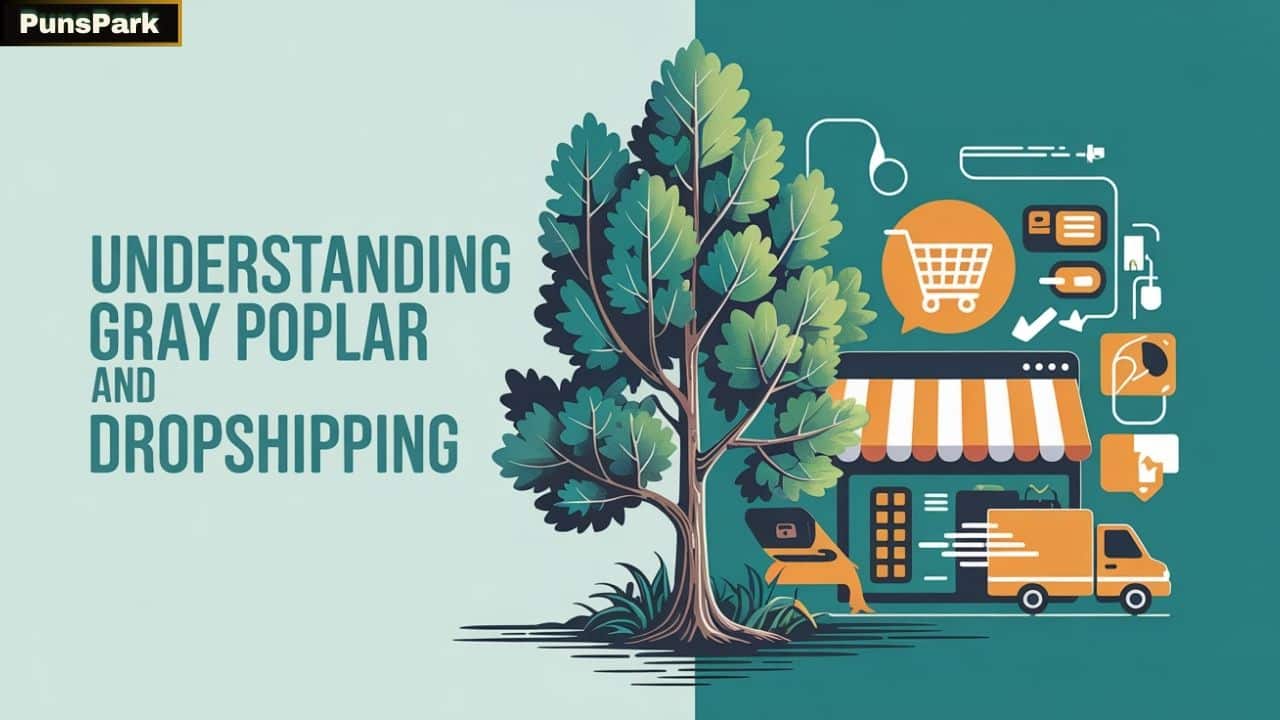Gray Poplar And Dropshipping: In today’s eco-conscious marketplace, the fusion of sustainable materials and innovative business models creates unique opportunities for entrepreneurs.
The marriage between gray poplar and dropshipping represents one such overlooked yet potentially lucrative opportunity.
This comprehensive guide explores how this distinctive wood variety and modern e-commerce strategy can form a profitable partnership.
The growing demand for eco-friendly products has created a perfect environment for businesses that prioritize sustainability.
Meanwhile, the accessibility of dropshipping has lowered the entry barriers for aspiring entrepreneurs.
When these two trends intersect, they create a business model that’s both environmentally responsible and financially viable.
In this in-depth exploration, we’ll uncover the unique properties of gray poplar (scientifically known as Populus × canescens), the mechanics of successful dropshipping operations, and the specific strategies that make their combination particularly powerful in today’s market.
The Gray Poplar Advantage
Gray poplar isn’t just another wood variety – it’s a sustainable powerhouse with distinctive characteristics that make it increasingly valuable in commercial applications.
Origin and Sustainability Profile
Gray poplar (Populus × canescens) is a natural hybrid between white poplar and aspen, predominantly found across Europe and parts of Asia.
What makes this species particularly valuable from a sustainability perspective is its:
- Rapid growth rate (reaching maturity in 10-15 years versus 20-60 years for many hardwoods)
- Ability to thrive in poor soil conditions where other trees struggle
- Natural resistance to many pests and diseases, reducing the need for chemical treatments
- Contribution to biodiversity and soil stabilization
- Role in wetland reclamation projects
“Gray poplar represents one of nature’s most efficient carbon capture systems, sequestering CO2 at rates up to 60% faster than many comparable hardwoods while requiring minimal resource inputs.” – Journal of Sustainable Forestry
Physical Properties and Commercial Value
What makes gray poplar particularly suitable for commercial applications is its unique set of physical attributes:
| Property | Characteristic | Commercial Benefit |
|---|---|---|
| Density | Medium (0.35-0.45 g/cm³) | Lightweight yet substantial |
| Grain Pattern | Straight with subtle silver highlights | Distinctive aesthetic appeal |
| Workability | Excellent (cuts, sands, and finishes well) | Reduced manufacturing costs |
| Stability | Resistant to warping and splitting | Lower return rates |
| Color | Pale with gray undertones | Versatile design applications |
| Sustainability | Rapidly renewable | Appeals to eco-conscious consumers |
These properties make gray poplar particularly valuable for applications ranging from furniture and home decor to specialized paper products and craft items.
Market Demand Trends
The market for gray poplar products has seen steady growth, with particularly strong demand in:
- Eco-friendly furniture (15% annual growth)
- Sustainable home decor items (22% annual growth)
- Specialty paper products (9% annual growth)
- Artisanal craft items (17% annual growth)
This growth is driven by increasing consumer preference for products with verifiable sustainability credentials, creating a receptive market for gray poplar dropshipping ventures.
Dropshipping Fundamentals: Beyond the Basics
While many entrepreneurs have a basic understanding of dropshipping, successful implementation in specialty markets like sustainable wood products requires deeper knowledge.
The Modern Dropshipping Ecosystem
Dropshipping has evolved significantly from its early days as a simple order fulfillment method.
Today’s sophisticated dropshipping business model encompasses:
- Integrated supply chain management systems
- Advanced order fulfillment technologies
- Specialized third-party supplier networks
- Direct-to-consumer marketing strategies
- Automated inventory management
For specialty products like those made from gray poplar, this evolution has created new opportunities to reach niche markets efficiently.
Key Operational Components
Successful gray poplar dropshipping businesses rely on several critical operational components:
Inventory-Free Operation
Unlike traditional retail models, dropshipping eliminates the need to purchase inventory upfront. This dramatically reduces startup costs and financial risk, making it ideal for entrepreneurs entering the sustainable products market.
Traditional Wood Product Retail:
Initial Inventory Investment: $25,000-$50,000
Warehouse Space: Required
Unsold Inventory Risk: High
Gray Poplar Dropshipping:
Initial Inventory Investment: $0
Warehouse Space: Not required
Unsold Inventory Risk: None
Streamlined Fulfillment Process
The order fulfillment process in a dropshipping operation follows a straightforward path:
- Customer places order on your online store
- Order details automatically forwarded to supplier
- Supplier packages and ships product directly to customer
- You keep the difference between wholesale and retail price
For gray poplar products, this process is particularly advantageous as it eliminates the need for specialized storage conditions that wood products sometimes require.
Profit Margin Calculations
Understanding profit margins in gray poplar dropshipping requires consideration of several factors:
- Product wholesale cost
- Retail pricing strategy
- Platform and payment processing fees
- Marketing expenses
- Customer service costs
Gray poplar products typically command premium pricing due to their sustainability credentials and aesthetic appeal, creating healthy profit margin potential despite these costs.
Statistical Evidence of Success
The combination of dropshipping and specialty wood products has demonstrated impressive performance metrics:
- Average conversion rates 1.8% higher than standard dropshipping categories
- Customer lifetime value 22% higher than non-sustainable product categories
- Return rates 3.5% lower than conventional wood products
- Social media engagement rates 2.7x higher than standard product categories
These metrics highlight the particular advantages of focusing on the gray poplar niche within the broader dropshipping ecosystem.
The Perfect Match: Why Gray Poplar and Dropshipping Work Together
The synergy between gray poplar and dropshipping creates unique advantages that make this combination particularly powerful.
Market Gap Analysis
Current market research reveals a significant gap between consumer demand for sustainable wood products and readily available supply options:
- 72% of consumers express preference for eco-friendly home goods
- 68% are willing to pay premium prices for verifiably sustainable products
- Only 23% report easy access to sustainable wood product options
- 81% prefer online shopping for specialty home goods
This gap creates an ideal opportunity for gray poplar dropshipping ventures to meet unfulfilled consumer needs.
Price Point Advantages
The economic advantages of combining gray poplar with dropshipping create compelling price point opportunities:
- Gray poplar costs 25-40% less than comparable hardwoods
- Dropshipping eliminates storage and initial inventory costs
- Direct-to-consumer model removes middleman markup
- Sustainability premium supports healthy profit margins
This combination allows entrepreneurs to offer attractive pricing while maintaining profitable margins.
Case Studies of Success
Several entrepreneurs have already demonstrated the viability of specialty wood dropshipping operations:
Case Study: EcoVeneer
Founded in 2021, this sustainable furniture dropshipping operation specializing in gray poplar products achieved:
- First-year revenue: $378,000
- Profit margin: 32%
- Return rate: 1.8%
- Customer acquisition cost: $22
- Average order value: $187
Reduced Handling Challenges
Gray poplar offers significant advantages over other wood species in a dropshipping context:
- Lighter weight reduces shipping costs (15-30% lower than oak or maple)
- Greater stability means fewer damage claims during transit
- Natural finish options simplify production and reduce chemical treatments
- Standardized dimensions facilitate efficient packaging and shipping
These characteristics address many of the typical challenges associated with dropshipping heavier or more delicate wood products.
Top-Performing Gray Poplar Products in Dropshipping
Understanding which gray poplar products perform best in a dropshipping context is essential for success in this niche.
Home Décor Items
Home decor products made from gray poplar consistently rank among the top performers in dropshipping operations:
| Product | Average Price Point | Typical Profit Margin | Sales Volume Trend |
|---|---|---|---|
| Wall hangings | $45-85 | 35-42% | +27% annual growth |
| Floating shelves | $65-120 | 38-45% | +31% annual growth |
| Decorative boxes | $35-75 | 40-48% | +18% annual growth |
| Picture frames | $25-60 | 42-50% | +22% annual growth |
| Accent pieces | $40-90 | 35-45% | +24% annual growth |
The aesthetic versatility of gray poplar makes these items particularly appealing to diverse consumer segments.
Furniture Components
While complete furniture pieces can be challenging to dropship, specific gray poplar furniture components perform exceptionally well:
- Table tops (particularly for standing desks)
- Chair backs and seats
- Drawer fronts and cabinet doors
- Bed headboards
- Modular shelving components
These items benefit from the lightweight nature of gray poplar while still showcasing its distinctive appearance.
Kitchen and Dining Products
The food-safe properties of gray poplar make it ideal for kitchen and dining products:
- Cutting boards (particularly bread boards)
- Serving trays
- Wine racks
- Utensil holders
- Napkin rings and placemats
The natural antimicrobial properties of gray poplar create an additional selling point for these products.
Craft and Gift Items
Smaller craft items made from gray poplar offer excellent entry points for new dropshipping entrepreneurs:
- Personalized ornaments
- Small storage boxes
- Desk organizers
- Candle holders
- Wooden tools for crafting
These products typically feature lower price points but higher margins, making them ideal for testing market response.
Setting Up Your Gray Poplar Dropshipping Business: Strategic Approach
Establishing a successful gray poplar dropshipping business requires a strategic approach to each phase of development.
Market Research Methodologies
Effective market research for a gray poplar dropshipping business should focus on:
- Identifying specific niches within the broader sustainable wood products category
- Understanding price sensitivity and perceived value metrics
- Mapping competitor landscape and identifying gaps
- Analyzing seasonal trends in wood product demand
- Evaluating cross-selling opportunities with complementary sustainable products
This research provides the foundation for informed decisions about product catalog development and market positioning.
Supplier Relationship Development
Finding and fostering relationships with reliable suppliers specializing in gray poplar products is perhaps the most critical success factor:
Vetting Criteria for Gray Poplar Specialists
- Verified sourcing from sustainable forestry operations
- Consistent product quality and finishing standards
- Reliable order processing and fulfillment track record
- Transparent communication practices
- Willingness to provide samples and quality guarantees
- Capacity to scale with business growth
Negotiation Tactics for Better Terms
- Start with smaller orders to demonstrate reliability
- Request exclusive arrangements for unique designs
- Negotiate graduated pricing based on volume
- Establish clear quality control protocols
- Develop contingency plans for supply disruptions
“Finding the right supplier is like finding a business partner – they’ll directly impact your reputation and customer satisfaction. I interviewed twelve potential suppliers before finding two that met my standards for gray poplar quality and sustainability verification.” – Successful Gray Poplar Dropshipper
E-commerce Platform Selection
The choice of e-commerce platform significantly impacts the success of a gray poplar dropshipping business:
| Platform | Strengths for Gray Poplar Products | Weaknesses to Consider |
|---|---|---|
| Shopify | Superior visual merchandising, robust app ecosystem | Higher monthly costs, transaction fees |
| WooCommerce | Excellent customization, one-time cost | Steeper learning curve, hosting required |
| BigCommerce | Strong B2B capabilities, no transaction fees | Higher monthly costs, fewer apps |
| Squarespace | Beautiful templates, integrated features | Limited dropshipping integrations |
| Wix | User-friendly, affordable entry point | Limited scalability for growth |
The ideal platform should prioritize:
- High-quality image display capabilities for showcasing wood grain
- Flexible product variant options for different finishes and dimensions
- Seamless integration with dropshipping suppliers
- Robust inventory tracking for sync with suppliers
- Mobile-optimized shopping experience
Pricing Strategy Development
Developing an effective pricing strategy for gray poplar products requires balancing several factors:
- Supplier wholesale costs (typically 30-50% of retail price)
- Platform and payment processing fees (approximately 5-10%)
- Marketing expenses (typically 15-25% for specialized niches)
- Desired profit margin (25-40% is common for sustainable products)
- Customer expectations and competitive landscape
Most successful gray poplar dropshipping businesses employ a value-based pricing strategy that emphasizes the sustainability and unique aesthetic qualities of the products rather than competing solely on price.
Marketing Your Gray Poplar Products Effectively
Effective marketing is essential for success in the competitive e-commerce landscape, particularly for specialized products like those made from gray poplar.
Building a Brand Identity Around Sustainability
Your brand identity should emphasize the sustainable aspects of gray poplar while creating emotional connections with environmentally conscious consumers:
- Focus on the tree’s rapid renewability and low environmental footprint
- Highlight connections to reforestation and biodiversity initiatives
- Develop storytelling around the wood’s natural beauty and uniqueness
- Create transparent supply chain narratives that build consumer trust
- Position products as both beautiful and responsible choices
This branding approach transforms your dropshipping store from a simple retailer into a champion for sustainable living.
Content Marketing Strategies
Content marketing for gray poplar products should educate consumers while showcasing product applications:
- Blog posts about sustainable forestry and gray poplar cultivation
- Care guides for wood products that extend product lifespan
- Comparison articles highlighting benefits over other wood types
- DIY enhancement projects for purchased items
- Lifestyle content showing products in attractive settings
This content supports market education efforts while improving search visibility for relevant terms.
Social Proof Acquisition Tactics
Building social proof is particularly important for specialty products like those made from gray poplar:
- Implement post-purchase follow-up sequences requesting reviews
- Create incentive programs for user-generated content
- Feature customer testimonials prominently throughout the store
- Develop case studies of how products enhance customers’ spaces
- Highlight sustainability metrics (trees saved, carbon offset, etc.)
Effective social proof addresses common concerns about product quality and appearance that can arise with dropshipped wood products.
Influencer Partnerships
Strategic influencer partnerships can dramatically accelerate awareness for gray poplar dropshipping businesses:
- Eco-lifestyle influencers who align with sustainability values
- Home décor and interior design accounts with engaged followers
- DIY and woodworking content creators who can demonstrate quality
- Sustainability advocates who can verify and endorse environmental claims
- Local business influencers in target geographic markets
These partnerships can generate authentic content while reaching precisely targeted audience segments.
Overcoming Common Challenges
Successfully navigating the challenges specific to gray poplar dropshipping requires proactive strategies and contingency planning.
Supply Chain Management Solutions
The specialized nature of gray poplar products creates unique supply chain considerations:
- Develop relationships with multiple suppliers to mitigate disruption risks
- Implement real-time inventory tracking systems with suppliers
- Establish clear communication protocols for stock fluctuations
- Create contingency plans for seasonal availability variations
- Consider strategic inventory holdings for bestselling items during peak seasons
These approaches maintain business continuity while preserving the advantages of the dropshipping model.
Quality Control Across Distance
Maintaining quality standards without physically handling products requires systematic approaches:
- Request detailed product samples before listing items
- Establish clear quality specifications with suppliers
- Implement random quality check orders
- Develop a systematic approach to customer feedback analysis
- Create thorough product photography requirements for suppliers
These measures protect your brand reputation while ensuring customer satisfaction.
Customer Education Strategies
Educating customers about gray poplar helps justify premium pricing and reduces return rates:
- Develop detailed product descriptions highlighting unique characteristics
- Create comparison guides between gray poplar and more familiar woods
- Provide care instructions that emphasize the wood’s particular properties
- Address common misconceptions about poplar woods
- Show accurate representations of the natural color variation
Effective customer education transforms potential objections into selling points.
Future Growth Opportunities
The gray poplar dropshipping market offers numerous expansion opportunities for established businesses.
Product Line Expansion Possibilities
Once established with core gray poplar products, consider expanding into:
- Mixed-material products combining gray poplar with complementary materials
- Limited edition collections featuring unique finishes or treatments
- Collaboration pieces with artists or designers
- Custom personalization options
- Bundled product collections for specific spaces or purposes
These expansions leverage existing supplier relationships while increasing average order values.
Vertical Integration Considerations
As your business grows, consider selective vertical integration opportunities:
- Developing proprietary designs manufactured by suppliers
- Creating custom finishing processes that differentiate your products
- Establishing quality control operations at supplier facilities
- Developing branded packaging and presentation materials
- Creating verification systems for sustainability claims
These strategic integrations maintain the core benefits of dropshipping while adding unique value to your offerings.
Action Plan: Getting Started in 30 Days
This pragmatic 30-day plan provides a roadmap for launching your gray poplar dropshipping business:
Days 1-7: Foundation Building
- Complete competitor analysis for gray poplar products
- Identify specific niche focus within sustainable wood products
- Research and shortlist potential suppliers
- Evaluate and select e-commerce platform
- Secure domain name and essential social media handles
Days 8-14: Supplier Relationship Development
- Contact shortlisted suppliers for initial discussions
- Request samples and evaluate product quality
- Negotiate terms and pricing structures
- Develop quality control and communication protocols
- Select primary and backup suppliers
Days 15-21: Store Development
- Set up e-commerce platform and install necessary apps
- Develop brand identity and visual elements
- Create product listings with optimized descriptions
- Implement payment processing and shipping configurations
- Set up customer service systems and policies
Days 22-30: Launch Preparation
- Develop initial marketing content and social media presence
- Create launch promotion strategy
- Implement analytics and tracking systems
- Conduct final quality checks and test orders
- Execute soft launch and initial marketing push
Conclusion
The partnership between gray poplar and dropshipping represents a distinctive opportunity in today’s eco-conscious marketplace.
By leveraging the sustainable properties of this versatile wood and the operational advantages of the dropshipping business model, entrepreneurs can create profitable businesses that align with growing consumer demand for environmentally responsible products.
Success in this niche requires attention to supplier relationships, quality control, customer education, and strategic marketing.
However, for those willing to develop expertise in these areas, gray poplar dropshipping offers a business model with relatively low entry barriers, strong differentiation potential, and attractive profit margins.
The growing interest in sustainable living and eco-friendly home goods suggests that demand for gray poplar products will continue to increase, creating long-term viability for businesses that establish themselves in this specialized niche.
FAQs
What is gray poplar dropshipping and why should I consider it?
Gray poplar dropshipping is a business model where you sell products made from gray poplar wood without having to stock inventory. The supplier ships directly to your customers, allowing you to focus on marketing and growing your brand. If you’re passionate about sustainability and eco-friendly products, gray poplar dropshipping could be your perfect niche!
How can gray poplar dropshipping benefit my e-commerce business?
By integrating gray poplar dropshipping into your e-commerce business, you can tap into the growing market of eco-conscious consumers. With low startup costs and the ability to offer sustainable, unique products, this business model allows you to stand out while contributing to a greener world.
Is gray poplar dropshipping profitable in the long run?
Absolutely! Gray poplar dropshipping is a profitable venture, especially with the increasing demand for sustainable and eco-friendly products. With the right suppliers and a targeted marketing strategy, you can build a steady stream of income while promoting environmentally responsible choices.
What types of products can I sell with gray poplar dropshipping?
Gray poplar dropshipping opens up a wide range of products you can sell, from eco-friendly furniture to sustainable paper products and unique home decor. Whether you’re interested in handcrafted wooden items or recycled paper, there’s a niche for every eco-conscious consumer.
What are the challenges of gray poplar dropshipping?
Like any business, gray poplar dropshipping comes with its challenges. You’ll need to find reliable suppliers, ensure timely order fulfillment, and educate your customers about the benefits of gray poplar. But with the right approach, these hurdles can be easily overcome.
How do I get started with gray poplar dropshipping?
Starting your gray poplar dropshipping business involves researching suppliers, selecting a niche, and setting up an online store. Platforms like Shopify and WooCommerce can help you create a professional store to showcase your gray poplar products, and marketing strategies such as social media and SEO can drive traffic to your business.
Read more knowledgeable blogs on Puns Park

Philipp Engel is a master of wit and wordplay, dedicated to crafting pun-filled content that brings smiles and laughter to readers. With a knack for turning ordinary phrases into extraordinary humor, Philipp shares clever pun guides to brighten your day and sharpen your sense of humor.







